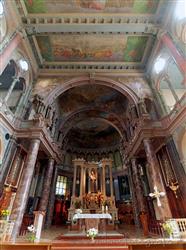|
Sanctuary of Sant'Antonio da Padova
|
|
|
Show an other treasure of art and history in Milan:
|
 Mostly represented styles: Eclectic - Art - Nouveau - Neorenaissance Mostly represented styles: Eclectic - Art - Nouveau - Neorenaissance
The Sanctuary of St. Anthony from Padua is a truly singular church. Built in the early twentieth century, it is characterized by a mix of different styles.
The only other Milanese church with which it may be comparable is perhaps the coeval and never completed Basilica of the Corpus Domini. In the latter, however, the styles present (Neo-Romanic, Neo-Byzantin, Art nouveau) are much more amalgamated together.
In the case of the Sanctuary of St. Anthony from Padua, in the contrary, there is one side a nice facade (and exterior), which imitates almost perfectly, but also without much creativity, the façades of the late Renaissance churches at the limit to the early stage of baroque (note the similarity, for example, with the façade of the Church of San Fedele). On the other side there is an interior (the most original and most successful part of the church in the opinion of the writer) in eclectic style with strong art nouveau elements, rich in colors, though with the prevalence of dark and dull tones.
Furthermore there is also a bell tower, characterized by contorted and not very much harmonious lines, especially if viewed from afar, which stylistically does not fit at all with the rest of the building.
Finally there is a note of giganticism, with two huge statues of St. Anthony of Padua, one on the main altar and one on the tip of the bell tower.
Designed by architect Luigi Cesa Bianchi, the church of Sant'Antonio da Padova was completed in 1904.
It is positioned between two converging streets. In order to support the course of the streets, the building gets narrower coming to the facade. This means that inside there is only one true nave, but with beside it two longitudinal spaces, sort of pseudonaves, which become narrower to almost disappear at the height of the counterfacade. On these spaces open the side chapels, three on each side.
Both the façade and the interior are on two orders.
The elaborate façade, divided into three parts by pilasters, includes three entrances and is dominated by a large triangular pediment on top in which St. Anthony is represented, with a baby Jesus in his arms and surrounded by a crowd of devotees. On the sides of the pediment there are four statues, perhaps depicting the four cardinal virtues.
Another feature characterizing the façade is the fake balcony in the center. Supported by two columns, it also acts as prothyrum.
The inside is divided up by semicolumns. The second order corresponds to the matroneum, i.e. to two grandstands that look out over the nave throughout the length of the church.
Overall, the church looks very dark as the light comes mainly from the windows on the façade and from not very large oculars underneath the ceiling, one between each two semicolumns (there are also some windows on the side walls, but only toward the entrance).
In this way it becomes unfortunately difficult to appreciate the rich pictorial decorations present on both the walls, the coffered ceiling and in the apse, especially as dull and dark tones prevail, as was often the case in art nouveau.
The many putti and angels with festoons on the walls are recognizable only when looking carefully. More recognizable are the paintings of the ceiling of the coffered ceiling, work of Attilio Andreoli and depicting episodes of the life of St. Anthony.
As for the beautiful decorations of the apse, representing the death and the glorification of the saint, also in this case works of the Andreoli, the situation is even worse and it is really difficult to recognize something in the darkness! They are best seen in photos, in the absence of a dedicated artificial illumination.
The apse is also characterized by the presence of two small lodges resting on three mighty columns each and decorated with triphors which link the matronees beside the nave with the ambulatory of the apse. Associated with the two lodges, eight statues of Franciscan saints.
In the apse there is the great statue of St. Anthony, in the center of what was once the main altar. The latter is the work of the sculptor Battista De Giorgi, while the statue of the saint - placed in the center of a semicircular temple and showing the saint while standing on a cloud surrounded by twelve angels and with the little Jesus in his arms - comes from the Milanese workshop of Giuseppe Nardini.
Also worth to be mentioned is the wooden chorus with forty-two places at the bottom of the apse.
As for the side chapels, we want to mention in particular the one dedicated to Saint Francis (Fig. 9), containing a marble statue work of the sculptor Michele Vedani in the center of a gold mosaic, and that of the Immaculate, also rich in mosaics and gold and containing a statue of the Madonna coming from the oratory that for some years had preceded the present church.
Finally we must not forget the fountain placed in 1932 in the crossroad at the joining of the two streets between which is the church is located. The work of the sculptor Giuseppe Maretto (1908-1984) depicts St. Anthony in the act of preaching to the fishes.
If you are interested in a guided tour of this monument send an email!
Categories: Churches / Religious buildings
Via Carlo Farini, 10, 20154 Milano, Italia |
Further pictures of the Sanctuary of Sant'Antonio da Padova in the section Photography |